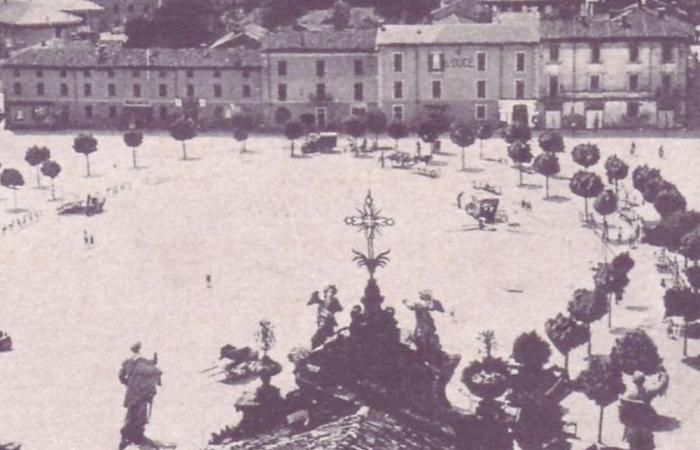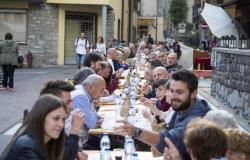To fully understand the dark years of the twenty years of fascism it is necessary to know the structure and functioning of the propaganda apparatus of Mussolini’s regime. The consensus was built, partly extorted, in any case organized from above. There was total control of the press, radio and cinema (Istituto Luce newsreels). They were completely new mechanisms for orienting public opinion and organizing the masses. To reach the entire population and have a widespread impact on those residing in areas far from the center of power and the oceanic gatherings of the capital, towns and cities were equipped with loudspeakers to broadcast the Duce’s proclamations in the squares, workshops and schools. On 10 June 1940 the radio announced an important speech by Mussolini for 5pm.
Loudspeakers were placed in Piazza Italia in Balsamo and Vittorio Emanuele (now Gramsci) in Cinisello to broadcast the declaration of entry into war. Maria Meroni from Cinisello clearly remembered that tragic moment. Everyone in the family was shocked by the fact that many had applauded the declaration of war. But it was a comment expressed within the walls of the house, because outside people were afraid to express themselves.
For fascism it was vital to build consensus by taking root in the territories, trying to use the structures already present for its own purposes: local territorial bodies, cooperatives and schools primarily. To this end, the black shirts local institutions established in Balsamo and Cinisello: the National Cooperation Body, to control the cooperative movement; the Opera Nazionale Dopolavoro, which absorbed the previous recreational and sports facilities; the Opera Nazionale Balilla, responsible for the education of young people. Schools, in particular, had to comply with the directives that required participation in public ceremonies, registration with fascist organizations and the adoption of the consolidated state law. Schoolchildren and students, whose role in the intentions of the regime was complementary and essential for the construction of new Italians, were mobilized in all ceremonies; this is also highlighted by the class registers, in which the teachers noted the anniversaries and the participation of the children and where the pervasive role of fascist education is clear. The School soon transformed into a place of remembrance for fallen soldiers and heroes.
In 1923 the Viale della Rimembranza was inaugurated in Cinisello in the area in front of the school and the town hall, where 60 trees were planted for the same number of fallen people. Guards of honor were established, made up of pupils, who were entrusted with the care of the votive forests. In 1927 all the classrooms were named after a fallen soldier, with a plaque affixed. On 3 April 1932, a ceremony took place in the school courtyard for the planting of a tree in memory of Arnaldo Mussolini, brother of the Duce and president of the National Forestry Committee. The teacher Adelaide Piccoli wrote in the class register: “It is a serious mourning, not only of Fascism, but it is a mourning of the Italian heart.” It can reasonably be assumed that the tree planted is the Atlas Cedar, now located between Il Pertini (then an elementary school) and the municipal building, in an area that was part of the school garden.
Also in ’32, all the classrooms were equipped with the symbolic representation of the Unknown Soldier. In the context of initiatives for children, heliotherapy colonies had arisen, a tool for ideological classification and indoctrination in close relation with sports practice; in fact, they were often located inside sports fields, which constituted an ideal setting for the staging of parades on the occasion of visits by hierarchs or other authorities. On 4 November 1931, next to the Cinisello primary school, the sports field, called Campo Littorio, was inaugurated, used for meetings, pre-military and gymnastic activities of the students. In addition to the football field there was an athletics track. Since 1932 it became the seat of the heliotherapy colony. In 1937 the colony was moved to the park of Villa Martinelli, from which it took the name of Colonia Martinelli. The teacher Caterina Vaghi, secretary of the local women’s fascist party, was appointed as director. In 1940 the Campo Littorio was given into custody of the Italian Youth of Littorio.
Symbols and myths capable of orienting and influencing all aspects of associative life and people’s existence were used and agitated. The inclusion of a large part of the Italian population in the organizations created by fascism occurred thanks to an associative structure that intended to cover from cradle to coffin the entire existence of Italians. A mass politicization that involved social classes that until then had been mostly unrelated to politics. Membership in the National Fascist Party, de facto mandatory for many professions and careers, made it practically impossible to draw a line between militant membership and bread tilesas they were called.
All the structures had in common the function they fulfilled and the presence of constant and unequivocal elements that referred to fascist ideology, through the choice of construction materials and the recurring icon of the fasces, present on public buildings, such as schools. In Cinisello it was also clearly visible on the high hanging tank of the aqueduct, inaugurated in ’31. In towns and cities there were numerous wall writings that conveyed the slogans and basic concepts of the regime, often attributed to Mussolini. They were celebratory, solemn texts, made visible from a distance, present on many public and private buildings, on the walls of houses at the entrances to towns, on fences and farmhouses, along road communication arteries or visible from railways. They also made their appearance in the countryside, on farms, on the facades of farmhouses and stables.
The writings were created according to the directives of the central government, or on the initiative of local bodies, or spontaneously, by individual sympathizers. Even those that were not signed with the classic “M” still saw the dictator in the foreground, signs of the Duce’s divinity and the strength of his word, like ipse dixit radiating its own, almost magical power. These were expressions with frequent use of imperatives or indicatives of an imperative flavor. Despite high rates of illiteracy, particularly in rural settings, the barrier of language understanding was not insurmountable.
The mottos were in fact characterized by an elementary linguistic structure, becoming one of the main means of propaganda, available even to the social strata that did not have access to the press and radio. The choice of the said fascists was made by the mayor, after agreement with the political secretary. The technician of our Municipality, after requesting estimates, submitted a report to both of us to decide which writings to refresh and which new ones to paint.
In our city, in ’39, there were 32 writings; if we consider that the streets and buildings were few, the number appears high. Just to name a few, in the gymnastics gym: “Peace, to be safe, must be armed”; on the wall of the G. Frova nursery school: “The faith is unique: the love of the homeland. There is only one desire: to make the Italian people great”; on the surrounding wall of the ALEA company, Piazza Vittorio Emanuele: “Only from the harmony constituted by the three principles: capital, technique, work, come the sources of fortune”; on the surrounding wall of the ECA (Municipal Assistance Agency) houses: “To last: with fidelity, with discipline; with absolute dedication”; on the facade of the GIL (now UTE) headquarters, via Cadorna/Beato Carino: “Believe, obey, fight”; along the streets of the town: “In the name of the Littorio we have won. In the name of Littorio, we will win tomorrow”, and so on. Finally, the writing “duce” stood out in various places, for example on the wall of a house in Cornaggia: “W il Re W il Duce”; while in the main square of Cinisello, on the facade of a house in front of the church, the writing “Il Duce” was clearly visible, in the exact point where a plaque, Speciale Spiga d’Oro, was placed in 2011, in memory of the socialist mayor Vincenzo Pozzi.
Patrizia Rulli
P.Rulli, AA.VV., The stones tell, Municipality of Cinisello Balsamo, 2011; PVCannistraro, The factory of consensus. Fascism and the mass media, Laterza, 1975; E. Meroni, Anti-fascism and Resistance in Cinisello BalsamoAmbrosiana, 1990. Photograph by Paolo Gobbo: Piazza Vittorio Emanuele, written “IL DUCE”.






